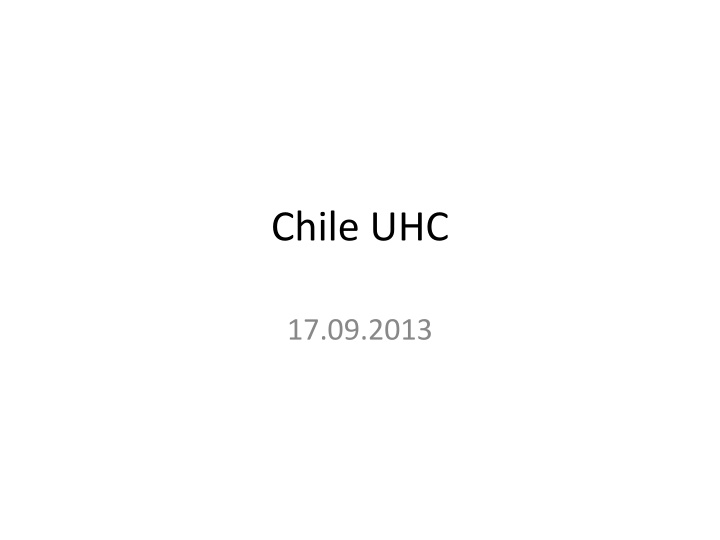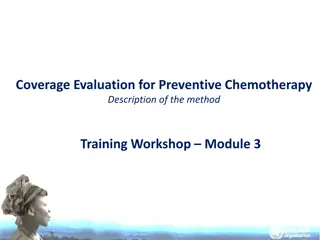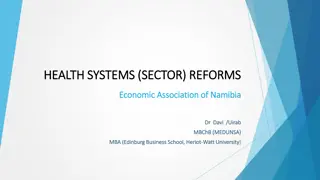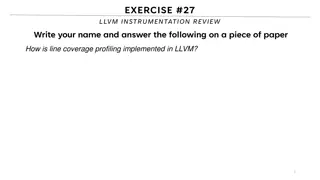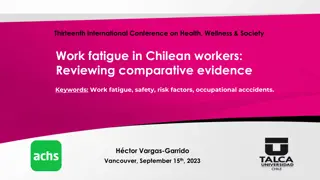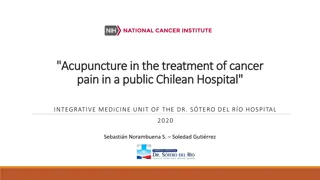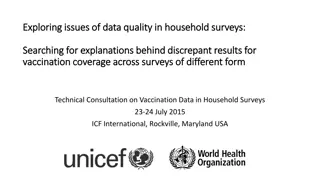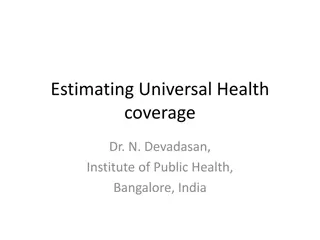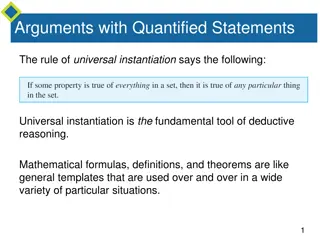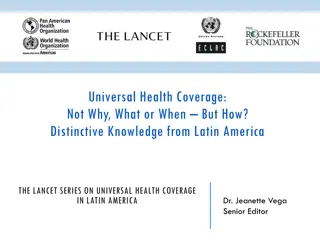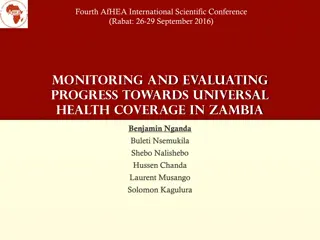Overview of Chilean Health System and Universal Health Coverage Progress
Chile's health system and progress towards universal health coverage are outlined with data on population, poverty rates, healthcare access, and economic development. The country's health financing structure, disease burden, and steps towards UHC implementation are also discussed.
Download Presentation

Please find below an Image/Link to download the presentation.
The content on the website is provided AS IS for your information and personal use only. It may not be sold, licensed, or shared on other websites without obtaining consent from the author.If you encounter any issues during the download, it is possible that the publisher has removed the file from their server.
You are allowed to download the files provided on this website for personal or commercial use, subject to the condition that they are used lawfully. All files are the property of their respective owners.
The content on the website is provided AS IS for your information and personal use only. It may not be sold, licensed, or shared on other websites without obtaining consent from the author.
E N D
Presentation Transcript
Chile UHC 17.09.2013
Outline Context Chilean Health System Measurement and Monitoring of UHC Discussion
Context: Chile at a glance 17,5 Millions total population (2013, INE) 21,590 PPP US$ GNI per capita (2012, WB) 14,4% Poverty (2011, CASEN) 87% Urban population (2013, INE) 79 Years Life expectancy at birth (2012, WB) 8 IMR per 1000 live births (2011, WB) 1% Child malnutrition 96% Access to improved water source 99% Literacy of population age 15+ (2009, WB) 0.54 GINI coefficient (2011, CASEN) Elderly population 65 years and over (INE, 2013) 9,7% Source: WB World Development Indicators 2011; OECD Statistics 2011
Chile: Economic, social and demographic evolution Poverty and extreme poverty (1990-2011) 25000 20000 50% 38.6% 15000 40% 32.9% 10000 27.6% 30% 23.2% 21.7% 20.2% 18.7% 5000 20% 15.1% 14.4% 13.7% 13.0% 9.0% 0 7.6% 10% 5.7% 5.6% 5.6% 4.7% 3.7% 3.2% 1960 1963 1966 1969 1972 1975 1978 1981 1984 1987 1990 1993 1996 1999 2002 2005 2008 2011 2.8% 0% 1990 1992 1994 1996 1998 2000 2003 2006 2009 2011 Poverty Extreme poverty GDP per capita (current US$) GNI per capita (PPP) 2013 1950 80+ 80+ 75-79 75-79 70-74 70-74 65-69 65-69 60-64 60-64 55-59 55-59 50-54 50-54 Female Female 45-49 45-49 40-44 40-44 Male Male 35-39 35-39 30-34 30-34 25-29 25-29 20-24 20-24 15-19 15-19 10-14 10-14 5-9 5-9 0- 4 0- 4 500000 400000 300000 200000 100000 0 100000 200000 300000 400000 500000 1000000 800000 600000 400000 200000 0 200000 400000 600000 800000 1000000
Chile: Burden of Diseases Injuries and Risk Factors 100% 12% 13% 15% 80% 60% 68% 77% 79% 40% 20% 17% 11% 8% 0% 1990 2000 2010 Comm/mater/neonatal/nutr NCD Injuries Source: IHME 2013
Chilean steps towards UHC ! ! ! ! ! ! ! ! ! ! ! ! ! ! !
Chilean Health System ! ! Sector! Armed! Forces! Public! Private! Funding! General! taxes! Mandatory! contributions! General! taxes! Mandatory! and!Additional! contributions! Copayments! Copayments! Firms! OOP! Local! taxes! Occupational!risk! insurance! Armed! Forces! FONASA! ISAPRE! Municipalities! SNSS!(SS)! Armed! Forces! Health! providers! Providers! Municipal!facilities! Public!hospitals!and!clinics! Private!providers! ISAPRE!beneficiaries:!18%! of!the!population,!upper! middle!and!high!class! FONASA!beneficiaries:!80%!of!the! population,!mostly!the!lower!class! Uninsured! (mainly!high!class)! Military!and!
Measurement and Monitoring of UHC Inputs Outputs Outcomes Prevalence of Risk factors Effective Coverage Impact Finantial Risk Protection Health Status
M&M UHC: Inputs Inputs: Chile and OECD countries Nurses and midwives density THE as% GDP Phisician density Nurses and midwives density PHE as% THE Hospital beds density PHE as% THE Hospital beds density Phisician density THE as% GDP Chile OECD Hospital beds density 4.8 Nurses and midwives density 11.1 THE as% GDP PHE as% THE Phisician density OECD 9.3% 72% 3.2 Chile 7.6% 45% 2.2 1.6 1.5
M&M UHC: Outputs Health Care Utilization per Income Quintile 2011 (per capita last three months source CASEN survey) .45 .40 .35 .30 .25 .20 .15 .10 .05 .00 I II III IV V I II III IV V I II III IV V I II III IV V I II III IV V I II III IV V Doctor consultation Specialist consultation Emergency room visits Dentist visits Lab RX-ECO
M&M UHC Outcomes: Coverage of Interventions Coverage of Intervention for NCD. Comparison public and private sector Coverage of Interventions for Communicable Diseases, Maternal and Child Health Depression DPT immunization HIV-AIDS ART coverage High Blood Pressure Prenatal services PAP smear Tb treatment success Contraceptive prevalence Private Public Improved Sanitation Skilled birth attendance Mampography Diabetes Indicator DPT immunization Prenatal services Contraceptive prevalence Skilled birth attendance Improved Sanitation TB treatmentsuccess HIV-AIDS ART coverage Coverage % 94 95 58 100 96 71 66 year 2011 1993 2006 2009 2010 2010 2011 Public 56.2% 40.0% 54.3% 47.0% 55.0% Private 82.1% 30.5% 78.6% 71.0% 61.0% year 2009-10 2009-11 2009-12 2011 2011 source source WB WDI WB WDI WB WDI WB WDI WB WDI WB WDI WB WDI Indicator Depression High Blood Pressure Diabetes Mammography PAP Smear MOH NH Survey MOH NH Survey MOH NH Survey CASEN Survey CASEN Survey
M&M UHC Outcomes: Effective Coverage Effective coverage of diabetes by educational level, Chile 2009-10 Effective coverage of HBP by educational level, Chile 2009-10 Diabetes knowledge Diabetes in treatment Diabetes compensated HBP Knowledge HBP in treatment HBP compensated 83.08% 70.02% 78.18% 75.93% 66.10% 64.98% 72.42% 63.56% 66.02% 55.16% 55.13% 50.97% 41.90% 37.90% 37.46% 37.91% 34.91% 34.86% 33.63% 29.84% 17.40% 16.78% 16.67% 15.97% LOW (< 8 years) Middle (8 - 12 years) High (>12 years) Total Low (< 8 years) Middle (8 - 12 years) High (>12 years) Total
M&M UHC Outcomes: Prevalence of Risk factors Prevalence of Tobacco Consumption Prevalence of alcohol risk consumption (AUDIT>8), total, by sex, educational level, area 60 50.3 45.549.4 44.2 50 42.5 41.3 37.1 35.7 40 25 27.6 19.7 25.6 30 20 20 13.2 15 12 10.9 10.4 10.3 10 8.6 10 0 2.5 Female Urban Low Male 65 and more High Rural Middle 5 15 - 24 25 - 44 45 - 64 0 Male Female Low Middle High Urban Rural Sex Educational level Area Sex Age Educational level Area Use of barrier methods during the last sexual relation, 2012 (15-29 years) Prevalence of high and very high cardiovascular risk, by sex, educational level and urban/rural area 70 60 35.0% 50 30.0% 25.0% 40 20.0% 30 15.0% 20 10.0% 10 5.0% 0.0% 0 Male Female Low Middle High Urban Rural Male Female Low Middle High Sex Educational Level Area Sex Socioeconomic level Source: MOH- Chile, National Health Survey 2009-10
M&M UHC Impact: Financial Risk Protection Out of pocket health expenditure as % total household expenditure/income*. Chile 2007 8 7.1 7 6.1 5.6 6 5 4.3 3.8 4 3.1 3 2.1 2 1 0 % of households facing catastrophic payments from out-of-pocket health expenses (>30% household capacity to pay) Quintile 1 Quintile 2 Quintile 3 Quintile 4 Quintile 5 Public Private Income System 5.7% 4.3% 2.5% 2.2% Sources: Cid, C. y Prieto, L., Rev Panam Salud Publica 31(4), 2012 Castillo-Laborde, Villalobos, Rev M dica de Chile , accepted for publication *By income quintiles: over total household expenditure; By system: over total income Quintile 1 Quintile 2 Quintile 3 Quintile 4 Quintile 5 2007 Average
M&M UHC Impact: Health Status IMR according to women education and zone. Chile 2010 16 IMR per 1000 live births 14 12 10 8 6 4 2 0 None None None 1-3 4- 6 7-9 1-3 4- 6 7-9 1-3 4- 6 7-9 10-12 10-12 10-12 13 + 13 + 13 + total urban rural IMR average years of education None 1-3 4- 6 7-9 10-12 13 + average Ratio 1-3/13+ total - 11,2 13,6 10,0 7,4 5,8 7,4 1,93 urban - 12,5 13,3 10,1 7,1 5,6 7,1 2,21 rural - 8,5 14,0 9,8 10,2 8,4 10,2 1,01
Discussion Over the last 60 years the Chilean health system has moved towards UHC, evidenced by the high coverage on primary health care and relative good performance on health indicators on average. However there are structural constraints that prevents further advance and determine the existence of important inequalities in terms of access, but more importantly, in terms of health results (e.g. geographic, socioeconomic, public/private system). For instance, the public expenditure on health (the total expenditure on health), is one of the lowest among OECD countries. Furthermore, an important component of the total health expenditure is financed through out-of-pocket expenditure (i.e. insufficient financial risk protection). At the household level, about 5% of the total expenditure/income is devoted to pay directly for healthcare services (although the % is greater for the better offs) There is important limitation in terms of the inputs. Specially in the public sector (human resources and facilities) On the other hand, the system is fragmented (at the pooling and providers level) Not allowing for a unique pooling of funds (but 1 public fund and 13 private funds). Therefore, there is an unequal availability of funds for the population served in both sectors, as well as unequal access (specially regarding more complex health care services such as surgical procedures and specialist consultation). Besides, there is risk selection (with the poorer, the older and the sicker going to the public fund).
Discussion The geographic characteristics of the country also impose difficulties in reaching the rural and extremely isolated population. There are still some gaps in addressing some increasingly important diseases (groups II and III). For instance, the dementias, enzymatic diseases, secondary preventive strategies (e.g. for some cancers). One of the major limitation in the measurement of indicators related to UHC is the availability of disaggregated data (specially at the health results level). In order to measure the advances in UHC, one possibility is to consider the specific health needs profile of each country according to the burden of disease study, as well as the relative importance of the three different groups (communicable maternal and child health, non communicable and injuries), and use tracer indicators of effective coverage for each group.
